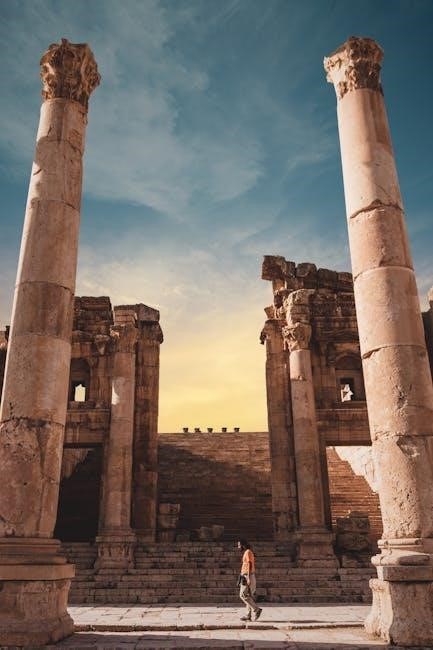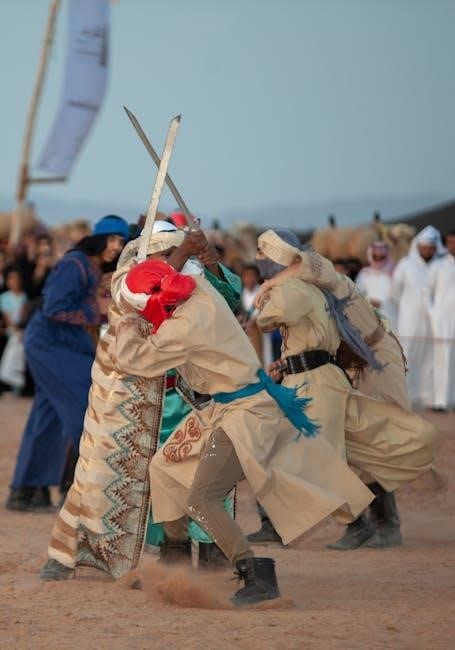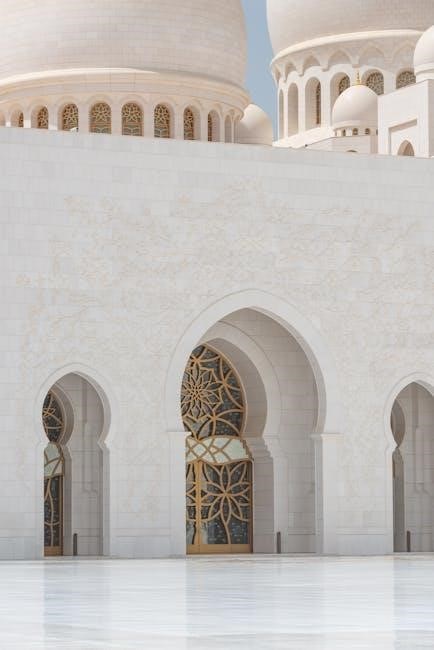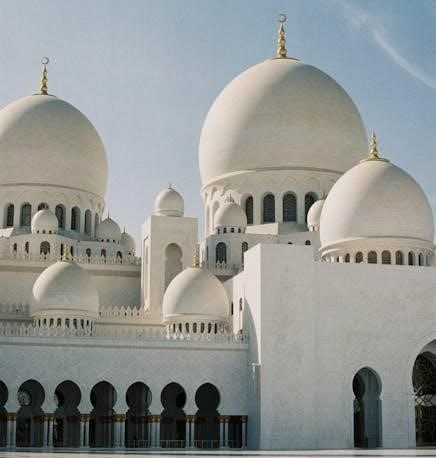Arabian Dances by Brian Balmages is a captivating concert band work that blends Middle Eastern cultural elements with vibrant musical storytelling‚ offering a unique auditory experience.
Overview of the Composition
Arabian Dances by Brian Balmages is a vibrant and programmatic work for concert band‚ inspired by Middle Eastern cultural influences. The composition combines authentic traditional melodies and rhythms with original music‚ creating a captivating auditory journey. It begins with a haunting opening‚ gradually unfolding into a dynamic interplay of contrasting moods and textures. The work seamlessly blends folk elements with modern orchestration‚ offering both emotional depth and technical challenges. Its structure is designed to evoke the richness of Middle Eastern heritage while maintaining a contemporary appeal‚ making it a compelling addition to concert band repertoire.
Historical Context and Inspiration
Arabian Dances draws inspiration from the rich musical traditions of the Middle East‚ blending authentic folk melodies and rhythms with contemporary orchestration. Brian Balmages was influenced by the region’s cultural heritage‚ incorporating elements that reflect its history and storytelling. The work captures the essence of Middle Eastern music‚ with its haunting phrases and intricate rhythmic patterns‚ while adapting these elements to the concert band medium. This fusion of traditional and modern elements creates a unique auditory experience‚ offering listeners a glimpse into the region’s musical legacy. The composition is both a tribute to its cultural roots and a fresh‚ innovative work.
Significance in Modern Concert Band Repertoire
Arabian Dances holds a prominent place in modern concert band music for its unique cultural blend and educational value. By integrating Middle Eastern folk elements with Western orchestration‚ the work diversifies the traditional repertoire‚ offering a fresh‚ global perspective. Its accessibility and artistic depth make it a favorite among educators and performers. The piece not only enriches concerts with its distinctive sound but also serves as a tool for teaching cultural appreciation and musical sophistication. Its popularity is further boosted by its availability in digital formats‚ ensuring widespread performance and study. This work continues to inspire new audiences and musicians alike.

Brian Balmages: The Composer
Brian Balmages is a prominent composer and educator‚ known for blending cultural influences with modern musical techniques. His works‚ like Arabian Dances‚ showcase his ability to create vibrant‚ educational‚ and artistically engaging music for concert bands‚ making him a respected figure in the genre.
Brief Biography of Brian Balmages
Brian Balmages is a renowned American composer and educator‚ celebrated for his dynamic and culturally rich compositions. With a strong foundation in music education‚ Balmages blends traditional and modern techniques‚ creating works that resonate with diverse audiences. His compositions often reflect a deep appreciation for global musical traditions‚ making him a prominent voice in contemporary concert band repertoire. As an educator‚ he has inspired countless musicians‚ emphasizing both technical mastery and artistic expression. Balmages’ ability to craft music that is both accessible and sophisticated has solidified his reputation as a leading figure in the field of concert band music.
His Contributions to Concert Band Music
Brian Balmages has significantly enriched the concert band repertoire with his innovative and culturally infused compositions. His works‚ such as Arabian Dances‚ seamlessly blend traditional melodies with modern techniques‚ creating engaging and educational pieces for ensembles. By incorporating diverse musical traditions‚ Balmages fosters cultural awareness and appreciation among performers and audiences alike. His compositions are celebrated for their balance of technical challenge and artistic expression‚ making them accessible to a wide range of skill levels while maintaining musical depth. This approach has established him as a key contributor to the evolution of concert band music‚ ensuring its relevance and vibrancy in contemporary settings.
Other Notable Works by Brian Balmages
Brian Balmages’ repertoire extends beyond Arabian Dances‚ showcasing his versatility as a composer. Notable works include Primal Dances‚ Jungle Dance‚ and collaborations that highlight his ability to blend cultural influences with modern musicality. His compositions often explore diverse themes‚ from the exotic to the adventurous‚ making them popular in concert band settings. Balmages’ music is celebrated for its technical challenges and emotional depth‚ appealing to both student and professional ensembles. His contributions continue to expand the concert band repertoire‚ ensuring his music remains a staple in performances worldwide.

Structure and Composition of “Arabian Dances”
Arabian Dances features a rich orchestration blending Middle Eastern elements with traditional concert band instrumentation‚ creating a dynamic and engaging musical journey through contrasting sections and themes.
Orchestration and Instrumentation
Arabian Dances is scored for standard concert band instrumentation‚ with careful attention to balancing traditional Middle Eastern elements. The work incorporates woodwinds‚ brass‚ and percussion‚ including auxiliary instruments like tambourine and hand drums to enhance rhythmic authenticity. The use of B-flat bass clarinet and piccolo adds depth and timbral variety. String sections‚ such as contrabass‚ provide harmonic foundation‚ while mallet percussion instruments like the xylophone add melodic sparkle. The orchestration seamlessly integrates these elements‚ creating a vibrant and engaging texture that reflects the cultural inspiration while maintaining the accessibility of modern concert band music.
Musical Themes and Motifs
Arabian Dances features a rich tapestry of musical themes‚ blending authentic Middle Eastern folk melodies with original compositions. The work opens with a haunting‚ modal theme played by the flutes‚ evoking the desert landscape. This motif recurs throughout‚ weaving through various sections and instruments. A lively‚ rhythmic dance theme emerges in the brass‚ showcasing the energy of traditional Middle Eastern celebrations. The interplay between these themes creates a dynamic narrative‚ from contemplative moments to exuberant crescendos. The motifs are developed and varied‚ maintaining listener engagement while preserving the cultural essence that inspired the composition. This thematic diversity adds depth and complexity to the piece.
Rhythmic and Melodic Elements
Arabian Dances showcases intricate rhythmic patterns and melodies inspired by Middle Eastern traditions. The composition often features uneven time signatures‚ such as 7/8 and 9/8‚ creating a sense of exoticism and energy. Melodic lines frequently employ modal scales and ornaments typical of Middle Eastern music‚ adding a layer of cultural authenticity. The interplay between legato woodwind passages and staccato brass accents highlights the dynamic contrast. Rhythmic motifs are layered and developed throughout‚ often building to climactic crescendos. These elements blend seamlessly‚ crafting a work that is both technically challenging and emotionally engaging‚ making it a standout piece in modern concert band repertoire. The music captivates listeners with its unique blend of tradition and innovation.

Cultural and Musical Influences
Arabian Dances draws inspiration from Middle Eastern musical traditions‚ incorporating authentic folk melodies and complex rhythms‚ while blending them with Western harmonic structures to create a unique sound.
Middle Eastern Musical Traditions
Arabian Dances reflects the rich musical heritage of the Middle East‚ incorporating traditional melodic motifs‚ intricate rhythmic patterns‚ and ornamental flourishes characteristic of the region. The composition seamlessly integrates the haunting‚ exotic sounds of Arabic music‚ such as the use of maqamat (melodic modes) and iqa’at (rhythmic cycles)‚ to evoke a sense of cultural authenticity. Balmages masterfully blends these elements with Western harmonic structures‚ creating a dynamic and captivating auditory experience. The work’s opening‚ with its ethereal flute melodies and driving percussion‚ immerses listeners in the vibrant spirit of Middle Eastern musical traditions‚ while maintaining a contemporary and accessible appeal for modern audiences.
Integration of Folk Melodies and Rhythms
Arabian Dances showcases Brian Balmages’ skillful integration of Middle Eastern folk melodies and rhythmic patterns‚ blending them seamlessly with original compositional elements. The work incorporates traditional Arabic musical motifs‚ such as the use of microtones and ornamental phrasing‚ to create an authentic cultural atmosphere. Rhythmic elements‚ including complex time signatures and percussive accents‚ reflect the vibrant energy of Middle Eastern music. By merging these folk traditions with contemporary harmonic and structural techniques‚ Balmages crafts a piece that feels both familiar and innovative. This integration not only honors the cultural heritage of the region but also introduces these rich musical elements to a broader audience in an accessible and engaging way.
Western Musical Elements in the Composition
Arabian Dances by Brian Balmages seamlessly incorporates Western musical elements‚ such as chromatic harmonies‚ contrapuntal textures‚ and structured orchestration‚ to create a dynamic and cohesive sound. The composition employs traditional Western concert band instrumentation while infusing it with Middle Eastern-inspired melodies and rhythms. Balmages’ use of harmonic progression and thematic development reflects his mastery of Western compositional techniques. The interplay between these elements creates a bridge between cultural traditions‚ making the piece accessible to Western audiences. This fusion of Western musical structure with Middle Eastern influences results in a work that is both innovative and deeply engaging‚ showcasing Balmages’ ability to blend diverse musical languages effectively.

Musical Elements of “Arabian Dances”
Arabian Dances by Brian Balmages explores Middle Eastern sounds‚ blending traditional melodies and rhythms with original compositions to create a captivating and emotionally rich musical experience.
Use of Melody and Harmony
Brian Balmages masterfully integrates traditional Middle Eastern melodies with contemporary harmonies in Arabian Dances. The work features haunting‚ exotic themes that evoke the richness of Middle Eastern cultural heritage. The interplay between melodies and harmonies creates a dynamic‚ layered sound that captivates listeners. Balmages uses modal interchange and chromaticism to enhance the emotional depth‚ blending familiar concert band timbres with the distinctive flavors of Middle Eastern music. This fusion results in a piece that is both accessible to Western ensembles and authentically evocative of its cultural inspiration‚ making it a standout in modern concert band repertoire.
Rhythmic Complexity and Time Signatures
Arabian Dances by Brian Balmages showcases intricate rhythmic patterns and shifting time signatures‚ reflecting the vibrant musical traditions of the Middle East. The composition frequently transitions between meters such as 7/8 and 4/4‚ creating a sense of energy and unpredictability. Syncopation and polyrhythms add layers of complexity‚ requiring precise coordination among ensemble members. These elements not only enhance the work’s authenticity but also provide a challenging yet rewarding experience for musicians. Balmages’ use of rhythmic variety ensures that the piece remains engaging and dynamic‚ making it a standout in contemporary concert band literature while maintaining accessibility for skilled ensembles.
Dynamic and Articulation Markings
Arabian Dances features a wide range of dynamic contrasts‚ from the soft‚ haunting opening to dramatic crescendos‚ creating a rich emotional landscape. Articulation markings such as legato‚ staccato‚ and marcato are used strategically to evoke the unique timbres of Middle Eastern music. Sudden shifts in dynamics‚ like sforzando accents and subito piano markings‚ add dramatic intensity. These elements‚ combined with precise articulations‚ require meticulous attention from performers to achieve the desired musicality. The interplay between dynamics and articulation brings depth and authenticity to the composition‚ making it both challenging and rewarding for musicians to interpret and perform.

Performance Considerations
Arabian Dances demands precise coordination‚ dynamic control‚ and technical accuracy. Conductors must emphasize rhythmic clarity and balance‚ while musicians should focus on articulation and expressive phrasing.
Rehearsal Strategies for Conductors
Conductors should begin by breaking down Arabian Dances into manageable sections‚ focusing on complex rhythms and dynamic contrasts. Start with sectional rehearsals to refine articulation and intonation‚ especially in the woodwind and brass sections. Use a metronome to establish precise tempos and ensure clarity in intricate time signatures. Prioritize balance and coordination between percussion and melodic lines to enhance the work’s Middle Eastern-inspired texture; Provide clear visual cues and verbal feedback to guide the ensemble through dramatic shifts in dynamics and articulation. Incorporate score study and listening exercises to familiarize the ensemble with the composition’s unique cultural and musical elements. Gradually build toward cohesive‚ expressive performances by addressing technical challenges systematically.
Technical Challenges for Musicians
Musicians face several technical challenges in Arabian Dances‚ particularly in navigating its complex rhythms and intricate time signatures. The piece demands precise articulation and dynamic control‚ especially in the woodwind and brass sections. Rapid passages and sudden tempo changes require strong technical proficiency. Additionally‚ the integration of Middle Eastern musical elements‚ such as unusual intervals and ornaments‚ adds a layer of complexity. Percussionists must master intricate rhythmic patterns‚ while the bass clarinet and alto saxophone solos present individual challenges. Ensuring a balanced blend between sections while maintaining clarity in layered textures is also critical. Musicians must practice meticulously to achieve the desired musicality and expression.
Logistical Considerations for Performances
Performing Arabian Dances requires careful logistical planning. Ensuring access to the sheet music and digital downloads is essential‚ as the work combines traditional and original elements. Rehearsal aids‚ such as recordings and interactive tools‚ can enhance preparation. The piece demands specific instrumentation‚ including a strong percussion section and soloists for certain woodwind parts. Conductors must manage rehearsal time effectively to address technical challenges and balance sectional dynamics. Additionally‚ the venue’s acoustics and seating arrangement should accommodate the work’s layered textures. Access to resources like the B-flat Bass Clarinet part and Middle Eastern-inspired elements must also be considered for an authentic performance. Proper planning ensures a polished execution.
Arabian Dances offers rich educational opportunities‚ fostering cultural awareness‚ enhancing technical skills‚ and encouraging musical exploration through its unique blend of Middle Eastern traditions and contemporary composition. Arabian Dances provides a rich platform for teaching musicality and expression‚ emphasizing phrasing‚ dynamics‚ and articulation. Its Middle Eastern-inspired melodies and rhythms encourage students to explore nuanced performances‚ blending traditional and contemporary techniques. The composition’s expressive elements‚ such as tempo fluctuations and ornamentation‚ challenge musicians to connect emotionally with the music. By studying Balmages’ integration of cultural influences‚ students learn to convey the unique storytelling and cultural essence embedded in the work. This piece fosters collaboration among musicians‚ as they work together to achieve a cohesive and vibrant sound‚ making it a valuable tool for developing musical expression and cultural understanding. Arabian Dances serves as a compelling vehicle for exploring cultural diversity‚ introducing musicians and audiences to Middle Eastern musical traditions. The work seamlessly integrates authentic folk melodies and rhythms with contemporary concert band instrumentation‚ bridging cultural gaps. By studying and performing this piece‚ students gain insight into the rich musical heritage of the Middle East‚ fostering a deeper appreciation for global cultural diversity. The composition encourages musicians to adapt to unique melodic and rhythmic patterns‚ enhancing their understanding of cross-cultural musical expression. This educational experience not only enriches musical knowledge but also promotes unity and respect for diverse traditions‚ making it a valuable cultural ambassador in concert band repertoire. Arabian Dances fosters technical and musical growth‚ challenging ensembles to refine their precision and coordination. The piece demands rhythmic accuracy‚ dynamic control‚ and harmonic balance‚ encouraging musicians to adapt to complex time signatures and layered textures. Its intricate melodies and counterpoint require strong communication and trust among sections‚ enhancing overall cohesion. The integration of Middle Eastern rhythms and motifs introduces unique phrasing and articulation challenges‚ prompting players to develop a keen sense of timing and expression. Through rehearsal and performance‚ Arabian Dances strengthens ensemble unity‚ preparing musicians for the demands of advanced repertoire while fostering a deeper understanding of collaborative music-making. Arabian Dances captivates audiences with its unique blend of Middle Eastern influences and traditional concert band elements‚ making it a popular and engaging choice for performances worldwide. Arabian Dances has garnered widespread acclaim for its seamless fusion of Middle Eastern musical traditions with contemporary concert band techniques. Audiences and critics alike praise its evocative melodies‚ rhythmic complexity‚ and emotional depth‚ often describing it as a standout piece in modern band repertoire. The work’s ability to transport listeners to distant cultural landscapes while maintaining accessibility has contributed to its popularity. Many reviewers highlight the composition’s educational value‚ noting how it introduces ensembles and audiences to diverse musical influences. Overall‚ Brian Balmages’s masterpiece is celebrated for its cultural richness and artistic brilliance‚ making it a beloved performance choice. Arabian Dances is frequently performed by concert bands worldwide‚ from school ensembles to professional groups. Its appeal lies in its accessibility and cultural depth‚ making it suitable for diverse venues. The piece is often featured in school concerts‚ community band performances‚ and international festivals. It is particularly popular in educational settings‚ where it serves as a valuable teaching tool. The work’s adaptability ensures it resonates in both intimate auditoriums and large outdoor stages. Its performance frequency underscores its status as a modern classic‚ bridging cultural gaps and enriching audiences across various settings and demographics. Arabian Dances captivates concert band audiences with its rich cultural tapestry and emotional depth. The work bridges cultural divides‚ introducing listeners to Middle Eastern traditions while maintaining accessibility. Its dynamic contrasts and lyrical melodies create an immersive experience‚ transporting audiences to distant lands. The piece not only entertains but also educates‚ fostering appreciation for global musical heritage. Performances often leave a lasting impression‚ inspiring curiosity and admiration for diverse cultural expressions. Its popularity endures as it continues to enrich the concert band repertoire‚ connecting audiences worldwide through the universal language of music‚ while showcasing the power of cultural exchange and artistic storytelling. Arabian Dances is widely available as digital sheet music and physical scores. Performers can access parts for instruments like flute and B-flat bass clarinet through platforms like MakeMusic Cloud‚ ensuring easy rehearsal preparation and performance. Additionally‚ interactive sheet music and rehearsal aids enhance the learning process for musicians. This accessibility makes the work a popular choice for concert bands seeking to explore Middle Eastern-inspired repertoire with modern arrangements and educational resources. Sheet music for Arabian Dances by Brian Balmages is readily available in both physical and digital formats. Platforms like MakeMusic Cloud offer interactive sheet music‚ enabling musicians to access scores and parts seamlessly. Digital downloads provide immediate access to individual instrument parts‚ such as flute and B-flat bass clarinet‚ making it convenient for educators and performers to prepare for rehearsals. Additionally‚ rehearsal aids and recordings are accessible online‚ fostering a comprehensive learning experience. This accessibility ensures that the work remains a popular choice for concert bands‚ blending traditional Middle Eastern elements with modern musical arrangements; Rehearsal aids and recordings for Arabian Dances by Brian Balmages are essential tools for musicians and educators. Digital platforms like MakeMusic Cloud offer interactive sheet music‚ allowing for tempo adjustments and part isolations to facilitate practice. Recordings of the piece provide a reference for conductors and performers‚ showcasing the intended interpretation and nuances. These resources are particularly valuable for ensembles aiming to capture the cultural authenticity and rhythmic complexity of the work. By leveraging these aids‚ musicians can refine their performance‚ ensuring a polished and engaging presentation of Balmages’ vibrant composition. Online resources for Arabian Dances include digital sheet music downloads‚ rehearsal aids‚ and interactive tools available through platforms like MakeMusic Cloud. These resources provide musicians with the ability to explore the composition in depth‚ offering features such as adjustable tempos and isolated parts. Additionally‚ educational materials and performance guides can be found online‚ aiding conductors and educators in effectively teaching the piece. These digital tools not only enhance accessibility but also support a deeper understanding of Balmages’ integration of Middle Eastern influences with contemporary concert band techniques‚ making them invaluable for both study and performance preparation.
Educational Value of “Arabian Dances”
Teaching Musicality and Expression

Exploring Cultural Diversity Through Music
Developing Ensemble Skills

Audience Reception and Popularity
Public Perception and Reviews
Performance Frequency and Venue Types
Impact on Concert Band Audiences

Availability and Resources
Sheet Music and Digital Downloads
Rehearsal Aids and Recordings
Online Resources for Study and Performance
